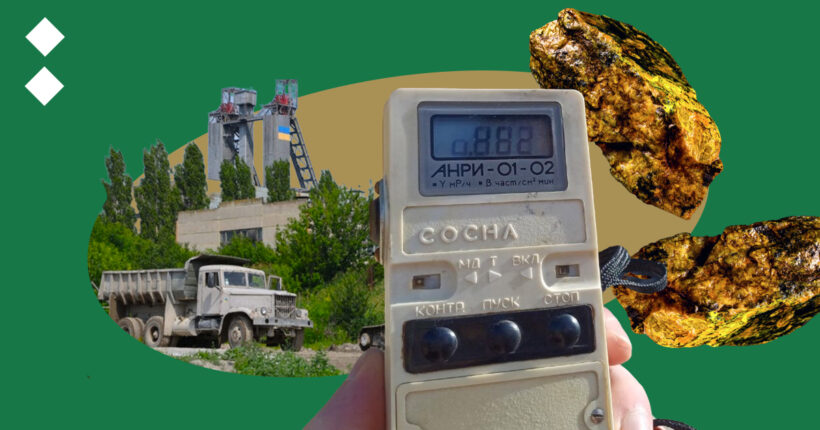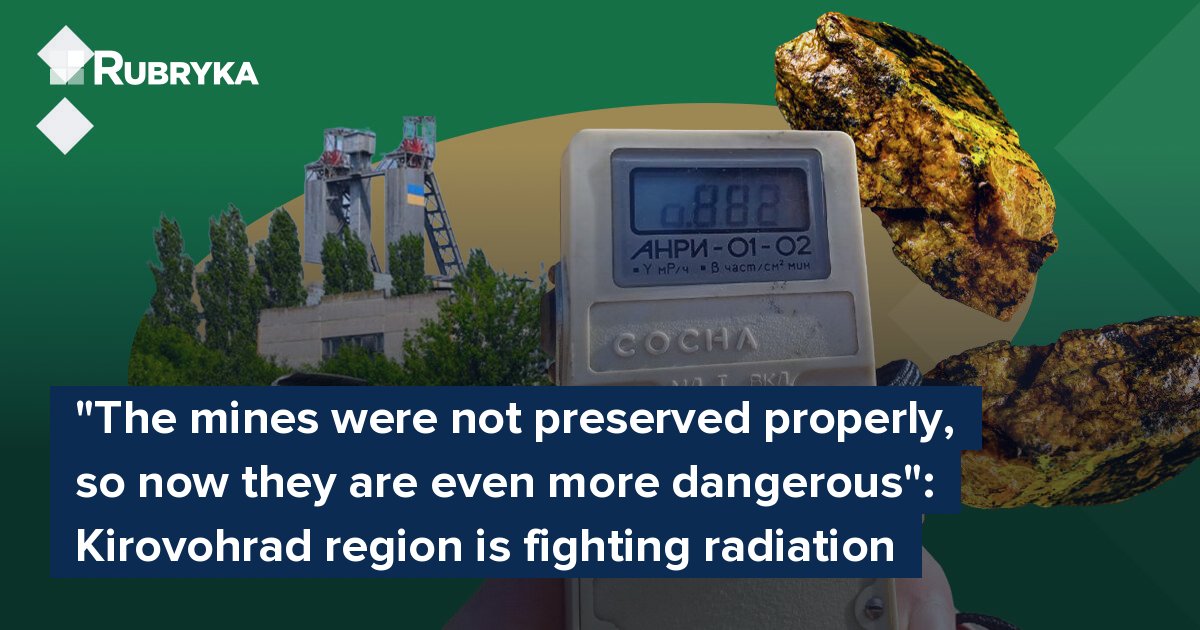
The implementation of the project, aimed not only at highlighting the problem but also at involving local activists in actions to reduce radiation risks, became possible thanks to the financial support of the Ministry of Foreign Affairs of the Czech Republic as part of the Transition Promotion Program. Iryna Muntyan, project manager of Flora and deputy executive director, told Rubryka about the project's work.
What is the problem?
The Kirovohrad region is located on the rocks of the Ukrainian crystalline shield, where most Ukrainian uranium deposits are concentrated. Uranium began to be produced here in 1945; during these years, some of the deposits were exhausted, and some mines are not being developed or are in a state of conservation.
Today, uranium ores extraction occurs at three mines, a critical issue for the country. Especially in the context of war and large-scale attacks by the Russian army on Ukraine's energy system because uranium is the main component for the production of nuclear fuel for nuclear power plants.
However, on the other hand, the extracting and processing of valuable raw materials brings a whole bouquet of environmental and health problems to the residents of Kirovohrad region.

The dosimeter records the excess radiation background near the dumps of the uranium mine in the Kirovohrad region. Photo: Flora NGO
"For almost 40 years, uranium has been actively mined right under the streets of the city of Kropyvnytskyi, as well as in the Smolinska and Malowyskivska communities. This created a high level of environmental pollution before, but the war brought new risks to our region," says Iryna Muntyan, Flora project manager. During martial law, almost all uranium mining enterprises stopped working. Still, the mines were not preserved properly, so now they are even more dangerous both for the environment and for people's health.
Muntyan gives the numbers: according to statistics, before the war in the Kirovohrad region, mortality exceeded birth, and the incidence of cancer was 426 diagnosed cancer patients per 100,000 population. In Kropyvnytskyi, these numbers are even higher — 472 per 100,000, the highest rate in Ukraine, with an average rate of 349.80.
According to the eco-activist, today, there is a real threat of flooding of uranium mines, which, accordingly, will lead to contamination of the hydrographic layers of the region with uranium and related radioactive substances and a decrease in the amount of water suitable for drinking.
In addition to three uranium mining facilities, the Kirovohrad region has radon coming out of the ground, which also affects the population's health. Therefore, reducing radiation pollution risks is important for locals and requires immediate action.
"We believe that the region's residents should not only be aware of the danger but should also actively cooperate with the authorities to reduce risks from the consequences of uranium mining activities," Muntyan explains. Examples of local solutions could be limiting the expansion of uranium mining territories, holding public hearings regarding the operation or conservation of uranium mining enterprises, creating forest protection strips around mines and uranium mining dumps, conducting regular monitoring by government and community representatives of the activity or inactivity of dangerous uranium production facilities.
What is the solution?
To create an ecologically safe environment for people in cooperation with communities
Flora NGO was created in 2000 as a children's environmental organization to support children and youth in their desire to change themselves and the world for the better. At the request of the times and following the current legislation, the organization was reorganized in 2015, and today, it is a non-governmental organization that takes care of the environment of the Kirovohrad region and implements the concept of Green Space in the territory of the region.

Teams of Flora and the NGO Yednist Sela Zlynka took water samples from local wells and boreholes for analysis. Photo of Flora NGO
The project "Dangerous neighbors — uranium mines. Double risk during the war" became a logical continuation of the activities of the NGO team. The project aims to involve residents of local communities in actions to reduce radiation risks due to non-working uranium mining facilities. In addition, the project uses successful strategies and lessons learned from European experts who have worked with serious problems of uranium contamination.
As part of the project and in cooperation with international partners, the NGO announced a competition for mini-grants for local communities. The best ideas for reducing the impact of radiation on human health and the environment were selected.

During the project, one of the grantees opened a podcast studio to inform the general public. Flora became the first participant in this project (Iryna Muntyan, second on the left). Photo of Flora NGO
Eleven communities of the Kirovohrad region won this competition. The winning teams included both residents of communities and representatives of local authorities. They investigated the problem at the local level and implemented their own projects. They monitored the quality of sources, created maps, installed air quality monitoring stations, conducted information campaigns, measured radon in schools, investigated the situation, and developed an action plan addressed to the authorities.
Thus, there will now be five air quality monitoring stations in the Pervozvanivska rural community of the Kropyvnytskyi district, outside of whose territory the Ingul mine is located. One of them was provided free of charge by Flora NGO. The community bought four more stations with grant funds. The operation of the stations can be monitored in real-time by following the link in the Telegram channel.

The first installed air monitoring station in Pervozvanivka. The station is located opposite the school. Photo of Flora NGO
According to Flora, the radiation level in Pervozvanivka itself is normal. But near the mine dumps, the dosimeter recorded 3.13 microsieverts per hour, with the permissible norm of 0.30 microsieverts. This is an exclusion zone and has no fence or warning signs. The NGO notes that dust from here flies to the regional center in windy weather. Protective afforestation is needed here. It is also done by the community, removing land from agricultural lands, mainly pastures.
"The Pervozvanivska community is the only one in the region that has a local environmental monitoring system," comments Muntyan. This community has been systematically working for more than a year to collect data on environmental pollution. "This is quite a progressive and, in our opinion, a vitally necessary solution. We are ready to continue supporting this community to monitor other environmental components as well."
Did they really succeed?
Flora's team notes that, in general, very conscientious work was carried out within the framework of the project. The population of the Kirovohrad region began to talk about the problems of radiation pollution and to be interested in its solution. In addition, the NGO established cooperation between the public and the authorities.
Thanks to the project, the level of public activity at the local level has increased significantly because financial support is an essential component. The ability to plan and implement community changes independently inspires local eco-activists to continue this activity and show visible results. "Our partners have put a lot of effort into informing community residents about the state of the environment. And the local self-government bodies provided comprehensive support to the project's activities, which indicates readiness to solve the existing problems now," says Muntyan.
Even more useful solutions!
"We are not fighting mines, but radiation pollution from the activities of these mines"
The Flora's team says that uranium is wonderful because it provides additional jobs, money in the community, and raw materials without which no nuclear power plant can do. If done correctly, there will be no disadvantages in the activity of a uranium mining facility.
"However, not in our case. Tons of tailings from the mines, which lie in public access, have radioactive elements, emit quite a lot of radiation, and are a real danger for us," Muntyan is convinced.
Recently, NGO representatives visited the Czech Republic, namely the Liberec region. There was also a uranium mine that did more harm than good. Czech activists conducted an extensive information campaign, began cooperating with the authorities and directors of the mines, developed a closure project, attracted funds, and started solving the problem. Yes, it took a lot of effort, money, and time, but now their mine is on the way to fully restoring the ecosystem disturbed during uranium mining.

The Flora's team on a tour of a Czech uranium mine. Photo of Flora NGO
This trip was an important stage in the fight against radiation pollution. The team was invited to a tour and shown all the processes, told about their project, and even given a look at the final result of their activities. The Gateman of the Liberec Region, Martin Puta, presented them with a radiometer to measure the amount of radon concentration in the premises and promised informational support.
In addition, the organization's team visited the Czech Institute of Radiation Safety, where they talked about radon protection of buildings, schools, kindergartens, and residential premises. They also visited DIAMO, a state enterprise that liquidated a uranium mining mine and is now engaged in mitigating the consequences of uranium mining in the Czech Republic.
"Today, we are only at the beginning of the path to our goal. Our Czech partners helped us understand our priority steps," Muntyan continues. "Today, we are making every effort to reduce cancer incidence among children in the Kirovohrad region. We understand that our future is in our hands, and while the armed forces of Ukraine are fighting for Ukrainian freedom, we are fighting for environmental security. After all, we have to live here, and we want to live in an ecologically safe environment."
Newsletter
Digest of the most interesting news: just about the main thing








